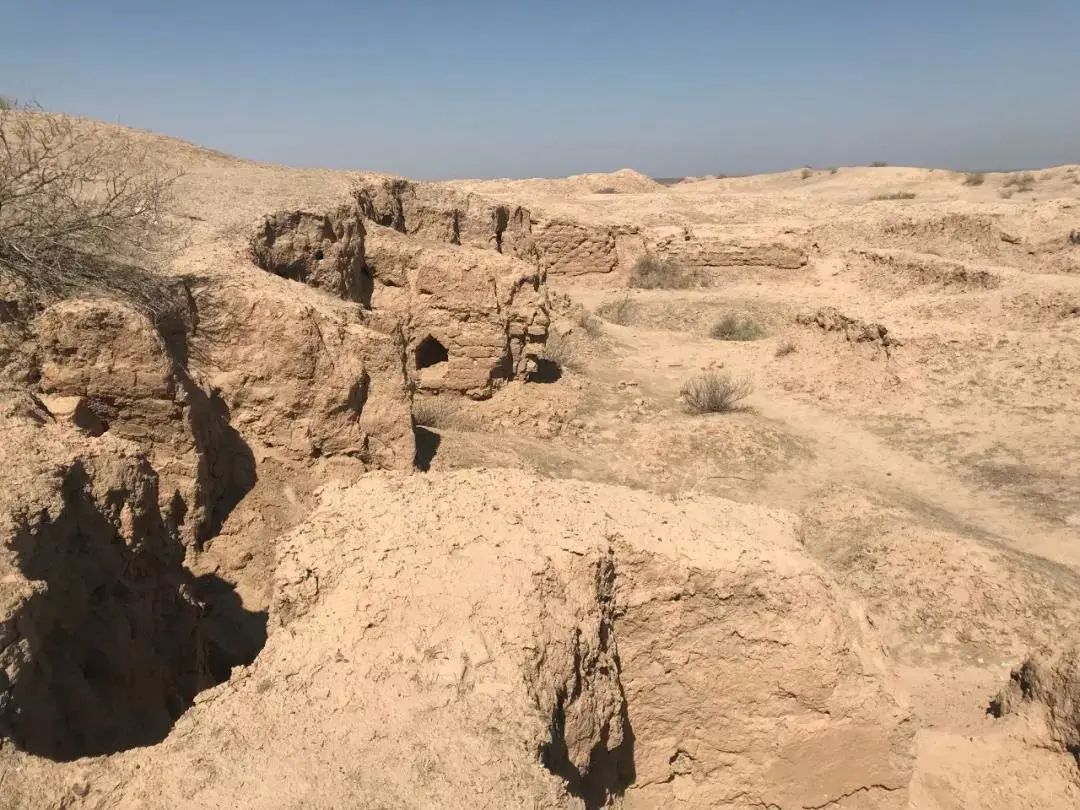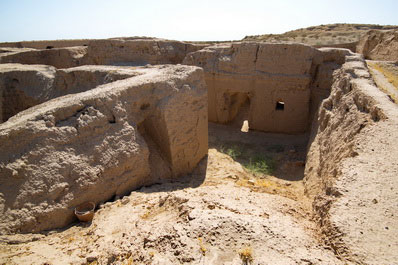遗产数据库
喀拉秋别佛寺遗址Kara Tepe
喀拉秋别(Kara-Tepe)佛寺遗址。遗址位于蒙古大军毁掉的铁尔梅兹古城西侧山丘上,属于边防控制区。我们先到山丘东侧距铁尔梅兹古城遗址很近的边防站,到边防军那里递交文件。斜挎冲锋枪的军人上车核对人数、证件之后,我们绕到山丘北侧进入遗址区。法浩特叮嘱我们不要到山丘顶部拍照,让哨楼上的士兵看见会有麻烦。一边听法浩特介绍寺院形制、发掘情况,一边对照资料上的出土文物恶补贵霜佛教考古,一边无法克制地、时不时地走神,向着山丘南侧的阿姆河张望,拍几张词不达意的照片——真的,照片上的阿姆河,完全没有我们看着它时所感受到的浑厚与紧张。
只有在喀拉秋别山顶才能看清阿姆河的主河道,看到河对岸阿富汗那边稀稀落落的芦苇,以及再远处映射着阳光的大片黄沙。沙漠如一道金色画框,把阿姆河从现实中切割出来,成为独立的风景。可是就在喀拉秋别这个位置,阿姆河一分为二,河里出现了一个很大的洲屿,即先知岛(Aral Paygambar,乌兹别克语写作Paygambar Orol)。因此,从喀拉秋别的遗址区看阿姆河,只能看见先知岛和东(北)河道,会感觉阿姆河不是那么宽,不大容易想到那只是一个岛,岛那边还有阿姆河的西(南)河道。
喀拉秋别遗址区
Kara-Tepa, Termez
Karatepa is a complex of Buddhist monasteries built across the ancient settlement of Old Termez. Centuries ago, this sacred site served as a hub for worship and spiritual practice. The origins of the complex date back to the flourishing period of the Kushan Empire in the II-III centuries CE, during the reign of King Kanishka I, a devoted patron of Buddhism. Karatepa emerged as a distinctive example of cultural fusion, bringing together Sogdian, Greco-Bactrian, and Persian linguistic traditions. Today, it stands as a powerful reminder of Uzbekistan’s rich historical legacy and remains a valuable archaeological site that continues to draw researchers and travelers from around the globe.
History
Buddhist culture reached Central Asia from India nearly 2,000 years ago. Kushan ruler Kanishka I, who reigned from 103 to 125 CE, became renowned as a supporter of Buddhism and a driving force behind the construction of temples and monasteries. During this time, Karatepa flourished as a stronghold for the spread of Buddhism across the empire. The multi-level temple and monastery complex spanned three hills and extended underground, with cave chambers and an intricate network of tunnels. This religious enclave welcomed both monks and local citizens, who could take part in ceremonies and offerings. Yet, the spiritual center remained active for only around two centuries. By the IV century, Karatepa had evolved into a necropolis, where former living quarters and prayer halls were repurposed for burials of monks and the elite. With the arrival of the Arab Caliphate and the rise of Islamic religious culture, the remaining Buddhist followers were forced to leave Termez and resettled in Kashmir, in northern India.
Finds
Kara-Tepa, TermezKara-Tepa, Termez
The Karatapa complex was first discovered in 1928 by an expedition from the State Museum of Oriental Cultures, but intensive excavations of the Buddhist center began only in the 1960s. Archaeologists uncovered residential chambers, temples, worship platforms dedicated to Buddha, and utility buildings. Within the labyrinthine cave system, they found numerous pottery fragments, oil lamps, jugs, figurines, coins, and remnants of wall paintings. These artifacts became invaluable additions to the collection now preserved at the Termez Archaeological Museum. Research continues today, deepening our understanding of Buddhist culture and the history of the Kushan Empire.
Cultural Significance
Kara-Tepa, TermezKara-Tepa, Termez
The Buddhist center at Karatepa played a pivotal role as a crossroads of cultural exchange and a key site for the spread of Buddhism. Here, local traditions merged with Buddhist teachings, enriching the spiritual and cultural fabric of Central Asia.
Karatepa became a vibrant center for Buddhist art, producing intricate murals and refined frescoes imbued with symbols and narratives drawn from sacred texts. These artworks not only served as spiritual instruction but also shaped the region’s aesthetic perception of Buddhism. In addition, the site functioned as an educational hub where monks studied Buddhist scriptures and philosophy.
Karatepa remains one of the most significant testaments to the cultural and spiritual flourishing of Central Asia during the Kushan era. Its ruins - still bearing traces of temples and exquisite murals - speak to centuries of inter-civilizational exchange and the enduring legacy of Buddhism. Today, Karatepa's heritage is closely studied by scholars, while countless finds, from ceramics and coins to fragments of wall art, are proudly displayed at the Termez Archaeological Museum.






